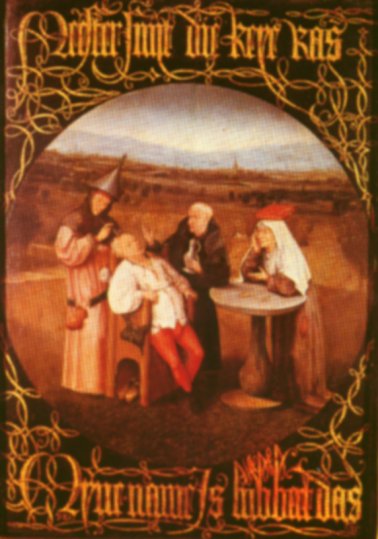Curing Folly
Hieronymous van Aeken (El Bosco), 1460-1516
(Prado Madrid; Photograph Giraudon, Paris)
The discovery of the Greek physician Claudius Galenos (129-199) that a death does not always occur when the brain is opened up, led to the idea that the 'evil falling sickness stone' could be surgically removed. However, as early as 900, the Persian physician Rhazes was criticising this method:
'Some wonder doctors claim that they can heal the falling sickness, they make a cross-shaped opening at the back of the head, and pretend to take something out which they had been holding in their hand...!'
Right into the 18th century there were stone cutters who belonged to the guild of barbers. They travelled the land as men skilled in the art of healing and earned a great deal of money with quack doctoring, black magic and the power of suggestion, playing on the superstition of the people but also instilling fear into those suffering from the disease.

Hieronymous Bosch mocks ignorance and the trickery of sick people in his picture Curing Folly, which he painted around 1485.
It belongs to a type of intentionally satirical paintings and engravings that were common in the Low countrys at the time.
A legend written in Ghotic letters says: "Master cuts out the stone - my name is Lubert Das"; the name here apparently meaning 'little gelded man', which also has the sense of 'simpleton' in Flanders.
The operation is being performed before a small audience. The quack doctor, crowned with a funnel, removes the stone from a fat, old man who gazes at us. A friar seems to sketch a blessing, while an old woman, who is balancing a book on her head, stars at the farce in bored contempt.
The scene is a fit subject for the kind of satire and criticism popular during the period from the 15th century onwards in Northern Europe.
--- close this window ---